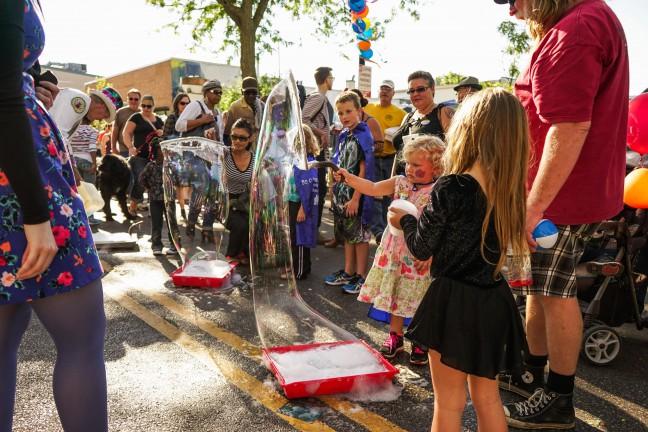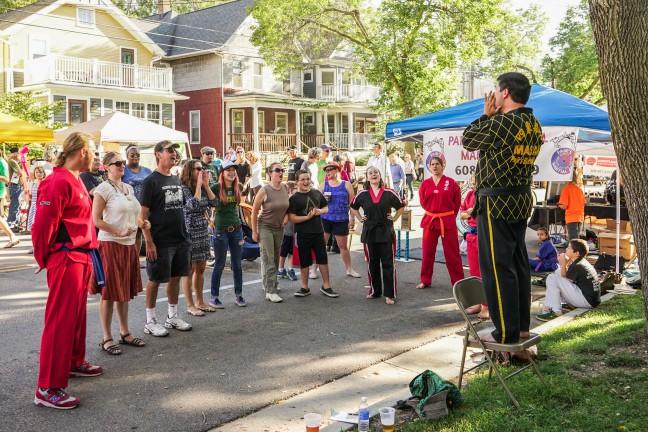As a student, Beatrice Hadidian found it hard to leave University of Wisconsin’s campus. But, Hadidian knew that just beyond the Capitol lay an annual festival deeply entrenched in the tradition of the east side with the essence of an international fair.
For 38 years, the Willy Street Fair has brought jaded students like Hadidian out from the cultural abyss of campus life, to join a close-knit community just east on the isthmus. This year was not much different from Sept. 19 to Sept. 20, as stilt-walkers and retro cars strolled down the strip.
Now as the Wil-Mar Neighborhood Center’s program director, Hadidian works to keep the tradition alive.
“It feels like a classic from the ground-up, crunchy granola street fair,” Hadidian said. “Like you’re going to see every different type of walk of life. It’s the classic street fair. There are new vendors this year and vendors that have been there for 20 years.”
12th annual Madison World Music Festival expands cultural horizons
Wil-Mar’s focus on community programming has led to three local festivals, including La Fete de Marquette, Atwood Fest and of course, the Willy Street Fair. The latter closed out the festival season with a two-day event featuring the largest community raffle, more than 200 vendors and seven live-music stages going all day.
In its oddball tradition, Willy Street Sunday was thick with locals blading, boarding and perusing the wares by foot. Older men with Packers caps and jerseys skirted around teens in vintage blades and bright fuchsia shirts.
Vendors hawked ethnic foods, clothes and jewelry and subscriptions to Wisconsin State Journal and Madison Roller Derby, the festival truly capturing the essence of Willy Street culture.
Henna, crafts, beer, wine, various pickled goods and other common festival favorites line the rows of vendors yearly, but the Willy Street Fair channeled the distinct quirkiness of the neighborhood with glassblowing demonstrations for Fat Pinky’s Glass, aura readings and a giant pumpkin weigh-off that sees several hundred pound gourds.
But, one of the highlights of the event blasted from the stages. In addition to the World Music Festival, which travelled from Memorial Union where they played the night before, the Willy Street Beats offered interesting tunes.
Started by Madison Music Review five years ago, the electronic stage includes DJs and performers with international origins, hip-hop and jazz influences and house intentions.
MitU, a Colombian duo, made their Midwestern debut as Willy Street Beats’ headliner. A hybrid of instrumental and electronic, the up-and-coming band was a departure from the local musicians that marked the lineup.
Foshizzle Family — a music and arts collective — was one of those local acts. Max Wasinger inadvertently created the Foshizzle brand working in a sign department; when he left messages for his coworkers, he would sign off by writing “foshizzle” in the white space of print rolls. He decided to print them on stickers, and when they began to spread across the city, a few DJ friends used them to promote a party in James Madison Park.
Now Foshizzle Family partners with Madison Music Review to put together Willy Street Beats each year. They added a danceable element to the event.
“There’s kind of like a universal beat that everyone seems to understand to a certain extent,” Wasinger said. “And when you put it in the right context it makes people want to dance.”
But, despite the worldly bangers and other bizarre festivities, Willy Street Fair is truly about supporting local programming.
Wil-Mar and their partner Commonwealth Development are staples of the near east community. The Wil-Mar Center has existed for 45 years and serves more than 100 people each Saturday, while also providing after-school programs for low income families, Hadidian said.
Commonwealth Development provides affordable housing and life skills training for Dane County. All the money the fair raises goes to these community programs.
“We have more than 800 people walking into the Wil-Mar using it for meeting space,” Hadidian said. “A space to work out, a space to dance together, to play music together, a space for people to meet for [Alcoholics Anonymous]. All the proceeds from the festival go back into letting us do that.”









